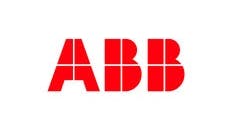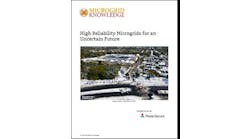India’s first fully fledged multi-source microgrid was inaugurated earlier this month, just in time to supply power to ABB’s Automation and Power World (APW) global customer fair in New Delhi.
Powered by solar and wind, the microgrid is equipped with a battery bank for power storage and balancing, and can island or supplement the main grid. During the three-day APW event, the microgrid avoided more than 1,300 kg of carbon emissions.
Better yet, it can generate enough clean energy to power some 4,000 rural households. In India, nearly a quarter of the population lacks access to electricity.
“Using microgrid technology, India can not only light up its remote villages, in line with the government’s power-for-all program, but also decentralize generation and optimize power usage in remote industrial installations or urban complexes,” said ABB Group CEO Ulrich Spiesshofer.
A reliable, clean power supply is imperative for India, where industries use 30 percent more energy than global benchmarks to manufacture a production unit.
***
During your next nighttime layover in Thailand, you’ll soon be able to take a spin around the Sky Lane — a 14.6-mile bike track at Suvarnabhumi Bangkok International Airport where Aquion Energy batteries are helping to keep the lights on.
Each of the 800 solar-powered LED lights lining the track will include a solar panel to charge the battery during the day, and an Aquion S-Line Battery Stack to discharge stored energy during nighttime hours and periods of cloud cover.
Once installation is complete, Sky Lane’s estimated 14,000 cyclists per week will be able to use the facility during nighttime hours.
Aquion’s Aqueous Hybrid Ion (AHI) batteries are particularly well-suited for Thailand’s hot and humid climate, and are some of the safest batteries in the world, according to the company. They contain no heavy metals or toxic chemicals, are non-flammable and non-explosive, and do not degrade from partial state-of-charge cycling — a common profile with solar-based systems.
Aquion batteries were also used as the storage component in a “live” hybrid AC/DC microgrid demonstration at Greenbuild 2015 in Washington, D.C. AHI batteries are optimized for daily deep cycling for residential solar, green architecture, off-grid and microgrid, energy management, and grid-scale applications.
***
The Switch, a supplier of megawatt-class electrical drives for wind energy and industrial applications, has launched a new full-power converter (FPC) for utility-grade electricity production. The FPC+ line of converters meet the strict international requirements for harmonics, flicker, and fault ride-through (FRT) — and also offer microgrid functions to enhance the FRT.
The Switch’s FPC+ reduces sensitivity to the network for a seamless interaction with the grid — even during severe disturbances. Because of the high power density of the FPC+, the number of panels can be reduced. Moreover, its compact size makes the converter easily adaptable to different applications. FPC+ can be configured as an inline or back-to-back solution.
***
Residents and businesses of Pulau Ubin, a small island in northeast Singapore, used to rely on diesel-power generators for electricity – which meant expensive repairs, big energy bills and the looming threat of outages. But a clean energy pilot program, now in its second phase, is seeking to leverage the island’s existing microgrid infrastructure, and to better understand how energy can be stored in Singapore’s hot and humid climate.
As Channel NewsAsia has reported, the Energy Market Authority has awarded $5 million to two projects: ATEN Pte Ltd. and Power Automation Pte Ltd. will test energy storage, and Berkeley Education Alliance for Research in Singapore (BEARS) will carry out real-time monitoring of the microgrid’s performance.
The energy storage test will look at three new types of batteries – Sodium-ion, Lithium-ion and Zinc–air – in hopes of identifying one that is more efficient in the humidity and produces less of a carbon footprint than the ol’ reliable lead batteries.
Phase Two will also see a greater sharing of the microgrid’s performance information. New sensors have been added to the microgrid’s electricity distribution points which will transmit information to the mainland, information that was previously restricted to the island itself.
One of the island’s major users of electricity is the Pulau Ubin Fo Shan Ting Da Bo Gong Temple, which sees thousands of visitors each year and needs to keep the lights on 24 hours-a-day. While its electricity bill has not yet dropped significantly (as it used to share a generator with other residents), there is one significant benefit of being part of the project: the silence the microgrid affords.
By mid-2016, all enhancements to the microgrid will be made and a review of the results of Phase Two is expected by end 2017. Visit channelnewsasia.com to read more about the project and its impacts on local residents.
***
The Medical University is deploying Green Power Pods to supply power for its pilot program of rapid-response mobile healthcare clinics, designed to be quickly deployed for disaster relief and for diagnosing and identifying outbreaks of pandemic diseases. The Green Power Pod is a portable 10KW solar-powered unit with a diesel back-up generator. It can be trailer mounted or packaged in a shipping container to provide quick, clean power.
“We are proud to provide our Green Power Pod products for such an important humanitarian effort,” said Lylette Utz, managing partner of Global Green Solutions. “We have combined another version of the Green Power Pod with Atmospheric Water Generators to create a mobile stand-alone off-grid operation which produces pure drinking water from the air. This can provide sustainable support in areas where safe drinking water is not available and could assist in providing sustainable food production and potential income for a family and can be expanded to villages worldwide using larger systems.”
***
How are power systems designed, operated and evaluated? The Performance Excellence in Electricity Renewal (PEER) program, modeled after LEED, sets standards and evaluates performance across four categories: reliability and resiliency, energy efficiency and environment, operational effectiveness and consumer contribution.
“As our energy landscape continues to evolve and change, and cities continue to embrace new technologies like solar, energy storage and microgrids, it is crucial to create tools to benchmark the performance of these power systems,” said David Chiesa, senior director, Business Development at S&C Electric Company.
S&C Electric Company is being recognized as the Founding Sponsor of Energy Innovation of the PEER program.
Got some microgrid news? Email [email protected], or read more Quick Microgrid News here.







